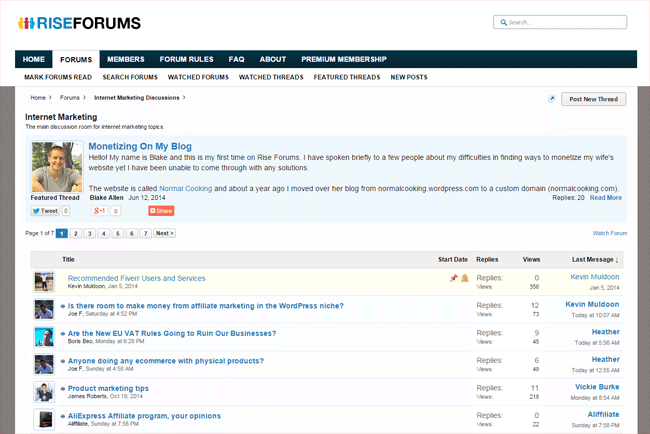Demographics, geographical location and psycho-graphic factors are some of the phrases thrown around when people talk marketing strategy. And rightly so, since these are among factors you need to keep in mind when starting a new business.
In other words, you need to have a clear understanding of your target customer to succeed in any business. Otherwise, you risk setting your sight too broadly, which will cost you a ton of marketing money and half of your audience down the road.
How do you define your target audience? And why is it even important? With a well-defined target audience, you know exactly how to craft your offer and marketing message for best performance.
You’ll be at a better position to create products and content that resonate best with your prospects. This ultimately leads to higher conversion rates and a fatter bank balance. Who wouldn’t love higher conversion rates and a heavier wallet?
In today’s post, we will show you how to define your target audience, so you can hit the ground running and concentrate on creating or improving your products. Enjoy and wow us with your thoughts in the comment section below!
Let’s start with the most obvious…
Identify Client Pain Points
So you have that great business idea keeping you up at night. You can feel it in your gut that this is it – the breakthrough you’ve been waiting for your entire life. You can’t wait to set up your WordPress website and make millions.
If only it was that simple, everybody would be on the internet selling all manner of stuff to everybody else. Oh wait, people are already doing that. My bad.
To find a sweet spot in your customers’ hearts, you must identify and then address their main pain points. You must appeal to your clients as the solution they need to solve their problem.
It is simple logic: Your prospect will not buy from you in a million years unless they have a problem to solve. Identify these problems and you start understanding and defining your target audience.
But how do you do it? How do you identify your clients’ pain points? Firstly, you must learn the intrinsic art of listening. Then, engage your prospects in discussion via Google Hangouts, forums, blog comments, phone and other channels available to you.
Don’t be afraid to tease out the pain points by asking hard questions. When you ask, you get answers and with these answers you can create a complete description of the person who is most likely to pay for your product.
If the above procedure does not yield the desired results which is highly unlikely, you can go ahead and analyze your products or services. Which problem does your product or service alleviate? To what extent does this problem trouble your prospects? The most motivated customer is the one with the most pressing need. Address this need with your product and your audience will come to you.
To take advantage of the biggest source of traffic, the search engine, you can leverage Google’s keyword planner or any other SEO keyword tool in your arsenal to discover the terms your target audience is using to find you.
Optimize your marketing message with these keywords and you’re half way there.
Who is Your Target Audience?
Who are your current and past clients? Why do your clients pay you for what you do? Which client brings in the most business? What do they have in common?

Answering such questions will, without a doubt, lead to a better understanding of your target audience, and if that’s not enough, the chance to refine your marketing strategy.
If you’ve customers already, it makes perfect scientific sense there are many other who could benefit from your product or service. It’s your job to target those clients with content marketing, SEO etc.
What if you’re just starting out and don’t have a pool of clients? What is the digital marketer to do? There’s one simple trick that works like magic. You know, abracadabra and the works. Offer free product trials and take the traffic through web analytics software, keeping record of the people who hit that “Buy Now” button.
Combine that with a mailing list and you have most of the work done. The general idea, after all, is to capture your target audience with a teaser of some sort and then evaluate how they will react to the actual product when or should you launch.
Many entrepreneurs such as Ramit Sethi, Neil Patel and Sean Ogle, warn against launching products out of the blue. Test products before launch to determine whether there’s a target audience. This way, you don’t have to invest a lot of time and capital in product development only to learn ‘build it and they will come’ is meant purely for motivational purposes.
You will notice you might need to redefine your target audience or restructure your marketing machinery to achieve favorable results. Change the plan, not the goal. Methodologies get you there – the goal should not change. Anyways, offer product trials, teasers – free candy to get your customers opening up.
Get an Edge Over Your Competition
How? By studying their game and beating ’em at it. You all want a bigger piece of the same pie. There’s enough for everybody, but a little competition doesn’t hurt – we’re all just playing a little game. They say keep your friends close and your enemies closer.
And if we’re targeting the same audience, in my world that’s competition right there and you become the enemy. But fluff aside, study your competition’s target market and you just might, just might, find a way to differentiate your business.
Oh the surprise; studying your competition might reveal nothing but the flaws in your marketing strategy, which is good by any means. So worry not; you just might find a niche the competition is overlooking. Your saving grace when trying to stand out is to create high-quality and unique content that is relevant to your target audience.
You must have a way of differentiating what you are doing from what the other guys offer – Bryan Darr, founder of Mosaik Solutions
Take Care NOT to Overestimate
Every digital marketer wants to believe the entire world wants their products. It’s human nature and as you know, human nature is a million miles shy of perfect. In that spirit. we easily take to assumption – the death of facts. Therefore, just get a more realistic picture of your target market by reaching out to them via social media, surveys, interviews, emails, blogs, and focus groups among others.
You can easily fall into this trap when starting out – you’re so passionate about the business idea and how good it is. The bubbling emotions in your gut will make you assume most people will automatically need your genius product.
Assumption can throw you ninety degrees off-course, so carry out proper market research beforehand, and you’ll not only define but also value your target audience.
All these channels of interaction are also rich sources of customer feedback. On top of that, responding to their queries on time is a great way of building brand trust. Don’t assume “everything will be alright”, get to work – get your hands dirty or hire help.
Leverage Social Networking
Speaking of customer feedback, social networking gives you one of the best ways to gather ‘unsolicited’ feedback about your products. What I mean is tweeps and other peeps on social media are a friendly lot, and they are always willing to offer free advice and opinion. Just don’t be a creep. Creeps spam. You don’t.

These opinions and pieces of advice will influence if not strengthen your understanding of the target audience. You cannot afford to ignore your prospects on social media. It’s a great source of web traffic second only to search engines, so yeah, you can thank me later.
A Little Personal Experience Won’t Hurt
With a little experience in your niche, comes a richer understanding of the target audience. But warnings from internet marketing experts caution us not to over-rely on personal or professional experience when defining the target market.
Reason being, no matter how long you work in any industry, you can never ‘truly’ think like your target audience. For instance, as a WordPress blogger, you might assume you know everything there is about your target audience of WordPress developers. Nothing could be further from the truth.
The best, and most probably the only, way to understand your target market is to interact with them – asking and talking to them. Personal experience is good but unless you’re part of your own target audience, don’t assume you can think like them.
Get Analytics Software
Google Analytics, KISSmetrics and others offer you a lot of insight about your web traffic. Thanks to advances in technology, analytics software can discern so much about your target audience. Your traffic is split down into various demographics and metrics, giving you an amazing and detailed look at the audience you’re pulling.
If you’re having a difficult time putting a finger on your target audience, a top-end analytics tool might just have the answer you’re looking for. That aside, analytics tools are easy to install and use. They also provide suggestions on re-marketing – how you can reach your audience easier.
Understand Your Business Model
How will you go about reaping profits from your business can inform your understanding of the target audience. Some revenue models will work for you and your target audience, and others simply won’t. For instance, it’s easy to overestimate the size the customer base with a social venture but it’s easier defining the target audience when all you have is a single product to sell online. That’s according to Robert Hisrich.
Another example, albeit a poor one. With a brick-and-mortar store, your target audience is mainly composed of the people in your neighborhood. If you throw a website into the mix, your target audience can be made up of people out of state. See where I’m going with this? Understand your business or revenue model and you get an idea of the people you will be dealing with on a regular basis.
Give Your Target Audience A lot
Defining your target audience only is not enough, you should endeavor to build relationships with your customers. Which is the best way of building relationships? Giving. Generosity is a formidable power that you can use to your advantage. Identify your customers motivations and keep an eye out for opportunities to offer your help.
If you want your people to dance to your tune, you must be ready to reciprocate. For instance, your support system shouldn’t be a one-way street. Everybody has professional goals, and the best way you can help them is finding a way of working together. Set up forums and communities around your brand, so you can interact with your audience while offering them the chance to interact amongst themselves.

Only good things can come out of this and within no time you will build a strong brand based on pinpoint understanding of your audience. In the words of Neil Patel, you get what you give.
Is Your Target Audience Expandable
The last thing you want in business is rigidity. You need to be flexible enough to redefine or expand your target audience in the future. Are you going to target domestic customers for the lifetime of your business or will you expand to international customers? Is your current target audience expandable…can you include other clients and still remain profitable? Ask yourself these questions.
Now You…
Defining your target audience from the get go means all the difference between success and failure. You just can’t shoot into the black expanse of space in the name of landing on the moon. Shoot for the moon, goddammit. Have you already defined your target audience? How did you do it? Have questions? Please ask or share with us in the comments section below. All the best!
Featured image courtesy Grant Wickes Grant Wickes.

